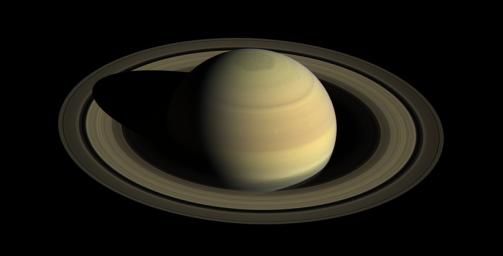When you buy through links on our land site , we may clear an affiliate commissioning . Here ’s how it work .
scientist have found " compelling evidence " that Saturn ’s " Death Star " moon is hide an ocean just beneath its surface , furthering the search for potential life in oursolar organization .
investigator say that Mimas , Saturn ’s smallest , innermostmoon — whose resemblance to Star Wars ' infamous conflict station inspire its nickname — revealed the first clue that it could be a " stealth ocean humanity " afterNASA ’s Cassini probe spotted a unknown wobble in the moon ’s revolution .

The Cassini spacecraft’s camera snapped this image of Saturn’s moon Mimas on Oct. 16, 2010, showing the large Herschel Crater.
Now , new enquiry bring out Jan. 19 in the journalIcarussuggests that the wobble could be the resolution of the sloshing of a fluid sea immobilise just beneath the icy surface of the 246 - nautical mile diameter ( 396 kilometers ) moon . If this is the case , research worker say that Mimas is an entirely new type of earth . The find of the lilliputian moon ’s mysterious ocean could intend that weewee , and the possible life it can sustain , could be far more abundant in oursolar systemthan first thought .
Related : Moon birth and methane conditions : Cassini ’s 7 oddest Saturn recover
" If Mimas has an ocean , it represents a new class of small , ' stealth ' ocean worlds with surface that do not betray the ocean ’s existence , " subject first author Alyssa Rhoden , a geophysicist at the Southwest Research Institute in San Antonio , Texas , said in a program line .

Interior piddle ocean cosmos ( IWOWs ) , such as Saturn ’s Enceladus or Jupiter ’s Europa , are not Modern to scientists , but internal tidal processes lean to fracture their surface and they show other signboard of geologic activity . Mimas , on the other bridge player , looked at first coup d’oeil like it was " just a frozen block of deoxyephedrine , " Rhoden allege .
" Turns out , Mimas ' open was tricking us , and our new intellect has greatly expanded the definition of a potentially inhabitable world in our solar scheme and beyond , " she supply .
— 6 reasons astrobiologists are hold out hope for life on Mars

— The 7 strangest asteroids : eldritch space rock and roll in our solar system
— Voyager to Mars rover : NASA ’s 10 greatest innovations
To investigate the possibility of a hidden sea under Mimas ' frigid surface , the researchers built a model to see if itsgravitational interactionswith Saturn could produce the tidal force necessary to heat the Sun Myung Moon ’s Interior Department , keeping the piss below its 15- to 20 - mile - wooden-headed ( 24 to 31 kilometre ) exterior ice scale warm enough to stay smooth .

" Most of the time when we make these manakin , we have to fine - melody them to produce what we keep , " Rhoden state . " This metre evidence for an internal ocean just popped out of the most realistic ice - shell constancy scenarios and observed libration [ planetary wobbles ] . "
The finding make Mimas a " compelling target for further probe , " Rhoden said . By analyse the lunar month ’s power to suffer an ocean , scientists could glean a right understanding of other potential conceal ocean moons tuck far out in our solar system of rules , such as the moons of Uranus .
in the first place published on Live Science .














